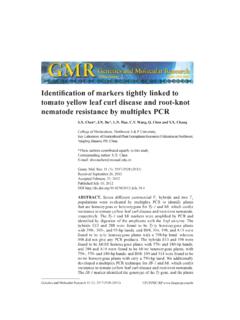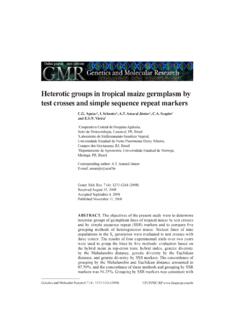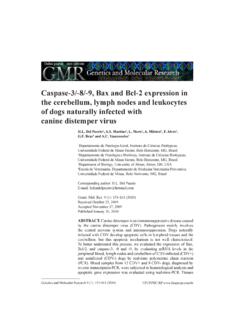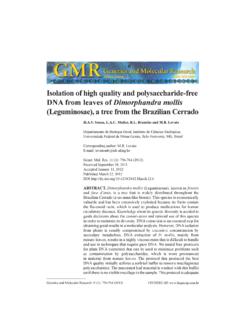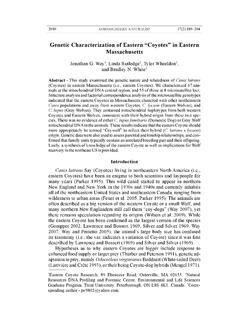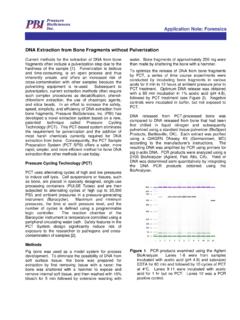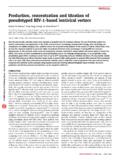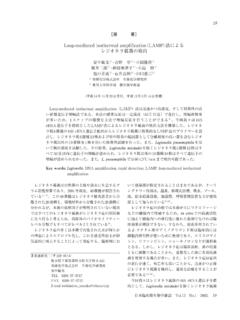Transcription of Application of RAPD for molecular characterization …
1 FUNPEC-RP and molecular Research 9 (4): 2191-9198 (2010) Application of RAPD for molecular characterization of plant species of medicinal value from an arid Arif, Bakir, Khan, Al Farhan, Al Homaidan, Bahkali, M. Al Sadoon and M. Shobrak molecular Fingerprinting and Biodiversity Unit, Prince Sultan Research Chair for Environment and Wildlife, College of Sciences, King Saud University, Riyadh, Saudi ArabiaCorresponding author: KhanE-mail: Mol. Res. 9 (4): 2191-2198 (2010)Received May 11, 2010 Accepted September 29, 2010 Published November 9, 2010 DOI The use of highly discriminatory methods for the identification and characterization of genotypes is essential for plant protection and appropriate use.
2 We utilized the RAPD method for the genetic fingerprinting of 11 plant species of desert origin (seven with known medicinal value). Andrachne telephioides, Zilla spinosa, Caylusea hexagyna, Achillea fragrantissima, Lycium shawii, Moricandia sinaica, Rumex vesicarius, Bassia eriophora, Zygophyllum propinquum subsp migahidii, Withania somnifera, and Sonchus oleraceus were collected from various areas of Saudi Arabia. The five primers used were able to amplify the DNA from all the plant species . The amplified products of the RAPD profiles ranged from 307 to 1772 bp.
3 A total of 164 bands were observed for 11 plant species , using five primers. The number of well-defined and major bands for a single plant species for a single primer ranged from 1 to 10. The highest pair-wise similarities ( ) were observed between A. fragrantissima and L. shawii, when five primers were combined. The lowest similarities (0) were observed between A. telephioides and Z. spinosa; Z. spinosa and B. eriophora; B. eriophora and Z. propinquum. 2192 FUNPEC-RP and molecular Research 9 (4): 2191-9198 (2010) Arif et conclusion, the RAPD method successfully discriminates among all the plant species , therefore providing an easy and rapid tool for identification, conservation and sustainable use of these words: molecular fingerprinting; Medicinal plants ; RAPD; Arid environmentINTRODUCTIONP lant species of the desert are adapted to tolerate multiple stresses including drought, high temperature, high solar radiation, high wind, and salinity (Batanouny, 2001).
4 It is note-worthy that besides their medicinal value, endangered mammals feed on many of the herbal plants growing in the desert. Recently, it was determined that about 35% of the species that constitute the standing vegetation are vulnerable to elimination because they are not represented in the seed bank of the Red Sea area (Hegazy et al., 2009). Therefore, appropriate measures for the preservation of plant species in the desert area are urgently needed. Proper identification is crucial for the preservation of plants growing in extreme arid regions.
5 Traditionally, subjective methods based on the morphological features such as shape, color, texture, and odor are used for the discrimination of herbal medicines. However, these methods are difficult to apply accurately for discrimination and authentication. The use of chromatographic techniques and marker com-pounds to standardize botanical preparations is also limited because the medicines have variable sources and chemical complexity, which is affected by growth, storage conditions and harvest times (Joshi et al., 2004; Zhang et al., 2007).Among the polymerase chain reaction (PCR)-based molecular techniques, random amplified polymorphic DNA (RAPD) is convenient in performance and does not require any information about the DNA sequence to be amplified (Weder, 2002).
6 Due to its procedural simplicity, the use of RAPD as molecular markers for taxonomic and systematic analyses of plants (Bartish et al., 2000), as well as in plant breeding and the study of genetic relation-ships, has considerably increased (Ranade et al., 2001). Recently, RAPD has been used for the estimation of genetic diversity in various endangered plant species (Wang et al., 2005; Lu et al., 2006; Liu et al., 2007; Zheng et al., 2008). In this study, we successfully utilized the RAPD technique for rapid characterization of 11 plant species of the Saudi Arabian AND METHODSP lant samplesThe young shoots (with intact leaves) from 11 plant species , 7 of them with known medicinal value, were collected from different regions of Saudi Arabia.
7 The samples were individually placed in sealable polythene bags, transported to laboratory, and then kept frozen until DNA extraction. A detailed description of these plant species is given in Table DNA isolationGenomic DNA was isolated from leaf samples. Leaf samples were placed in a sterile 2193 FUNPEC-RP and molecular Research 9 (4): 2191-9198 (2010)RAPD in plant species of medicinal valueSpecies number species Family Medicinal use 1 Andrachne telephioides L. Euphorbiaceae - 2 Zilla spinosa Prantl.
8 Brassicaceae Removing kidney stones (Heneidy and Bidak, 2004) 3 Caylusea hexagyna Green. Resedaceae - 4 Achillea fragrantissima Asteraceae Anticancer (melanoma cell lines) (Sathiyamoorthy et al., 1999) 5 Lycium shawii Roem. & Schult. Solanaceae Antibacterial (Mossa el al., 1987) 6 Moricandia sinaica Boiss. Brassicaceae - 7 Rumex vesicarius L. Polygonaceae Antidote for scorpion venom, laxative, sedative, depurative (Middleditch and Amer, 1991) 8 Bassia eriophora (Schrad.) Asch. Amaranthaceae - 9 Zygophyllum propinquum migahidii Zygophyllaceae Asthma, antihelminthic (Ghazanfar, 1994) (Hadidi) & Chaudhary 10 Withania somnifera (L) Dunal Solanaceae Anti-inflammatory, antitumor, antistress, antioxidant, immunomodulatory, hemopoetic, rejuvenating (Mishra et al.)
9 , 2000), antitumor (Devi et al., 1996)11 Sonchus oleraceus L. Asteraceae Anti-typhoid (Grace et al., 2004)Table 1. Description of plant species FUNPEC-RP and molecular Research 9 (4): 2191-9198 (2010) Arif et containing liquid nitrogen and thoroughly crushed with a sterile pestle. The powdered leaves were subjected to DNA extraction. An anion exchange chromatography-based DNeasy Plant Mini Kit (Qiagen, Valencia, CA, USA) was used for genomic DNA isolation and pu-rification. The purity and quantity of isolated DNA were determined spectrophotometrically (GeneQuant-1300; GE Healthcare, Buckinghamshire, UK).
10 RAPD-PCR analysisReady-To-Go RAPD analysis beads (GE Healthcare, Buckinghamshire, UK) were used for RAPD-PCR analysis. The PCR mixture of 25 L contained a single Ready-To-Go RAPD analysis bead, 25 pmol of a single RAPD primer, 50 ng of template DNA and sterile distilled water. The bead contained thermostable polymerase (AmpliTaq DNA polymerase and Stoffel fragment), dNTPs ( mM each), BSA ( g) and buffer (3 mM MgCl2, 30 mM KCl and 10 mM Tris, pH ). Five primers (GE Healthcare) were used in this study. Each primer is a 10-mer of arbitrary sequence: a (5-GGTGCGGGAA-3), b (5-GTTTCGCTCC-3), c (5-GTAGACCCGT-3), d (5-AACGCGCAAC-3), and e (5-CCCGTCAGCA-3).


